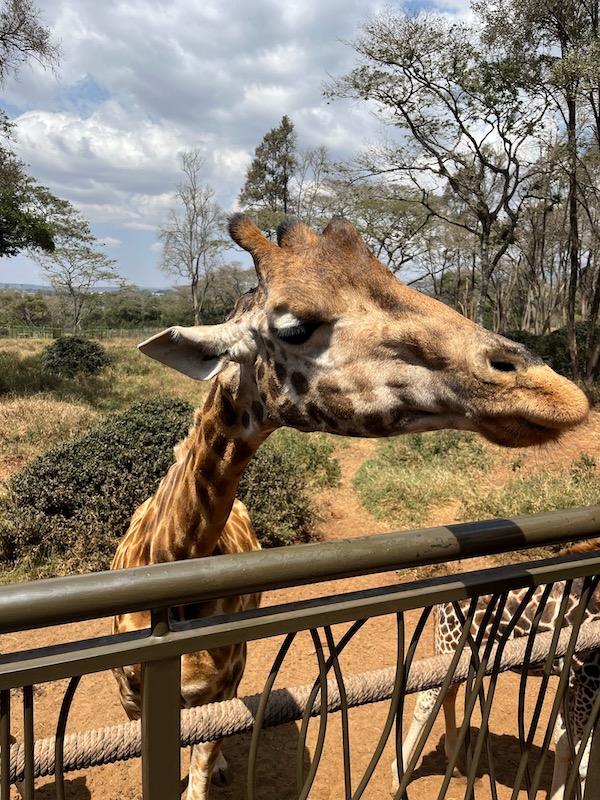The Giraffe Center is considered by many to be a “must do” in Nairobi. Visitors enter the center and immediately there are handwashing stations which visitors are encouraged to use because the highlight of the Giraffe Center is feeding the giraffes.
We walked on a raised wooden path that led us to a ranger that gave us each a little coconut bowl of “giraffe snacks” that appeared to be dried grass pellets. We followed the wooden path onto a raised platform where we could hand-feed the 10 giraffes that live at the Center. Although conscientious travelers should rightfully be wary of zoos that offer wild-animal feeding, the Giraffe Center is legitimately invested in the well-being of the animals and its mission is to educate Kenyan youths in wildlife and conservation. It was such a special experience to interact with these gentle creatures up close.
While the other kids took to feeding the giraffes immediately, EY was initially afraid of reaching her hand out to feed the enormous animals. She didn’t like their long black tongue which can extend to about a half-meter long. Then we spotted a baby Giraffe, named Betty, who was only 8 months old. EY loved feeding the calf who was having trouble getting any snacks because she was just barely tall enough to see over the edge of the wooden platform.
Apart from giraffes, there were a number of warthogs prancing around near the giraffes. We met a very engaging guide who asked us if we saw Pumba. We all knew that Pumba was the warthog from The Lion King. We learned that Pumba means “stupid” in Swahili. The reason the warthog is given that name is because it has a very very short memory of only about 50 seconds. Warthogs and giraffes work together as a team. Giraffes, who can see up to 2 km away, will alert warthogs when a predator, like a lion, is nearby. Once alerted, the warthog will run for its life. However, after a few seconds, it forgets why it was running and often circles back to the same place it started, sometimes ending up a tasty meal for the lion. Meanwhile, the giraffe has had ample time to run to safety.
We looked through the visitor’s center that shared the 40 year history of the Giraffe Center. Originally, the Center was created to help save the most endangered Giraffe species called the Rothschild Giraffe, that can be identified by their “white socks”. Over the years, the Center’s mission shifted to education of local school children. While tourists pay for entry at the Center, schools can organize free visits for their students. In the visitor center, there is a board with letters of thanks written by various educational institutions that had benefited from the free program. I read through a few and found the letters quite touching.
We were lucky enough to stumble upon a presentation given by a guide named Daniel. He showed us the femur of a giraffe’s hind leg. The back legs of a giraffe are extremely strong because they are pure bone, with no bone marrow. The kick of a mature giraffe’s hind legs can instantly kill a lion.
Daniel shared with us that one of the important tasks at the Giraffe Center is breeding. Of the 10 giraffes who live at the center, seven were bred and born there. Every year, the center releases 3 giraffes back into the wild. With the help of the Giraffe Center, the Rothschild giraffe is no longer on the Endangered list and since 2010, it has been classified as “vulnerable”. From near extinction, the Rothschild giraffe currently numbers close to 2,500.
Author
-

Song is the mother of four children. She and her family have stepped away from it all and in September 2023, began traveling the world while homeschooling. Song is an ABC (American born Chinese) and has an undergraduate degree from Cornell and an MBA from Harvard. She is an entrepreneur and an educator. Her hobbies include learning, traveling, reading, cooking and baking, and being with children.

